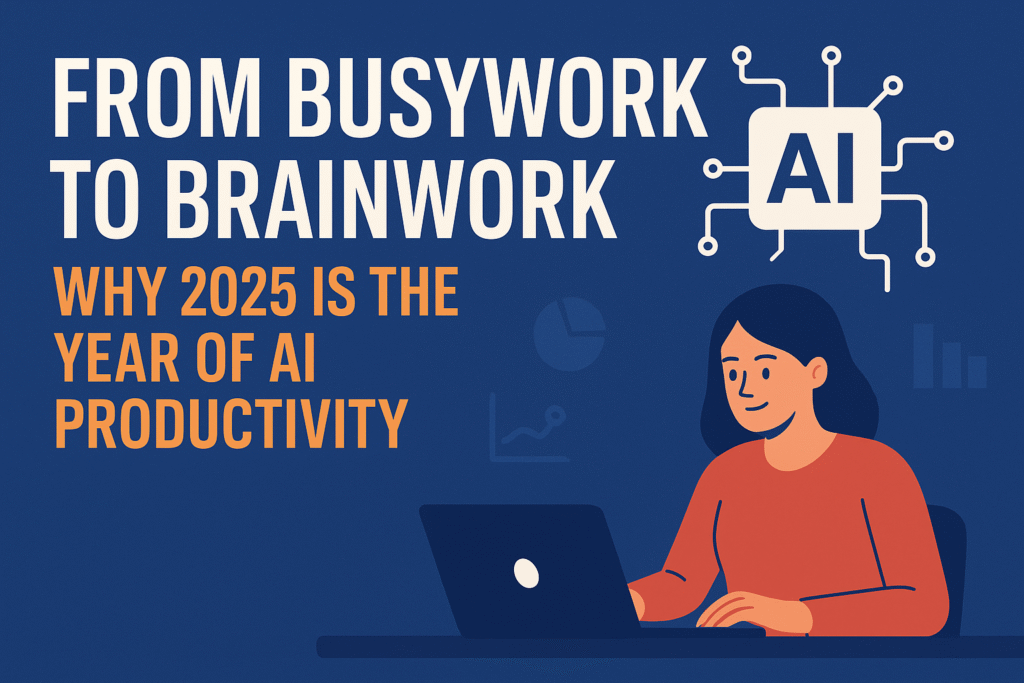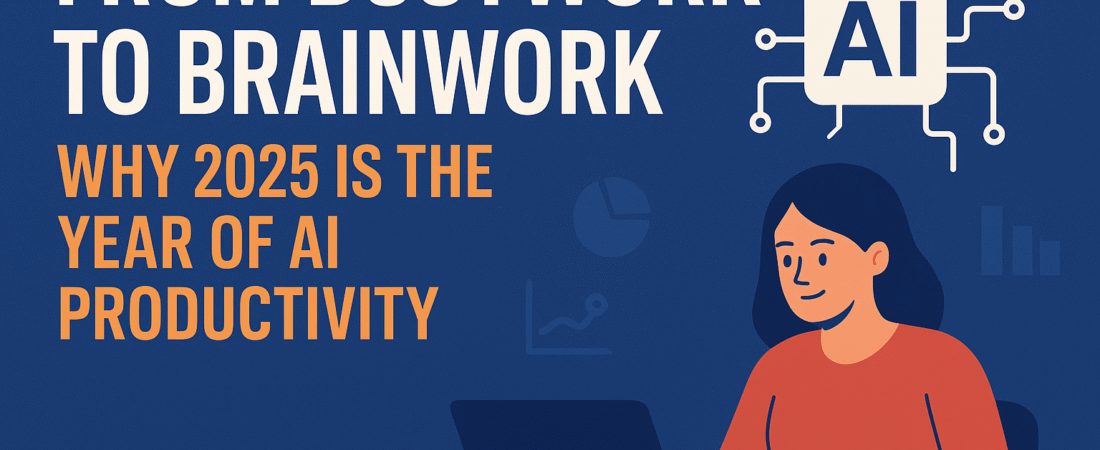
From Busywork to Brainwork: Why 2025 Is the Year of AI Productivity
Introduction: The End of the Busywork Era
If 2023 and 2024 were the years when AI got its buzz, 2025 is the year it gets to work.
As I’ve tested dozens of AI-powered workflows myself, from automating content creation to managing client onboarding, I’ve seen firsthand how AI is no longer a “nice-to-have” tool. It’s becoming the operating layer of productivity itself.
The truth is, we’re finally moving away from “doing more” to “doing what matters.”
AI doesn’t just speed up manual tasks, it eliminates them.
The Productivity Gap: Humans Are Not Meant for Repetition
For decades, productivity meant busyness. Emails, spreadsheets, meetings, follow-ups, it all looked productive, but rarely moved the needle.
When I tracked my own work hours in 2022, I realized almost 60% of my time went into repetitive admin tasks. AI flipped that ratio.
Tools like AI scheduling assistants, automated writing systems, and workflow builders now let founders, freelancers, and teams reclaim their time for deep work, the kind of thinking that actually builds value.
AI, in essence, is teaching us to work smarter and slower, in a good way.
2025: The Rise of AI Productivity Systems
What’s different about 2025 isn’t just the AI hype; it’s the integration.
Instead of using dozens of disconnected apps, businesses are adopting AI-first systems that centralize workflows, communication, and data under one intelligent layer.
For example:
- AI CRMs that auto-write emails and follow-ups based on tone and context.
- AI project managers who allocate tasks dynamically, predict bottlenecks, and optimize delivery timelines.
- AI data dashboards that summarize reports and suggest decisions instead of just displaying charts.
In my tests, these systems didn’t just save time, they made me rethink what “work” means. The goal shifted from “doing tasks” to “making better decisions.”
The Human Advantage: Creativity, Strategy, and Meaning
The biggest misconception about AI productivity? That it’s replacing people.
The truth is more exciting: AI is removing the noise so humans can focus on meaning.
When I started outsourcing busywork to automation, writing drafts, generating reports, and managing outreach, I noticed something strange:
I wasn’t working less; I was working smarter.
That extra time turned into brainstorming sessions, creative strategy, and personal learning.
AI handled the repetition; I handled the innovation.
In 2025, the most successful professionals won’t be those who can “do everything”, they’ll be those who know what to delegate to AI.
The Productivity Equation: Human + AI = Leverage
Think of AI not as an employee but as an amplifier.
When I integrated AI into my workflow, I wasn’t just saving time; I was multiplying my output.
Here’s what that looks like in practice:
- 1 person with AI tools can now run operations that used to require a 5-person team.
- AI agents handle repetitive actions while humans focus on high-value strategies.
- Insights are delivered in real-time, not days later after manual analysis.
This shift is why I believe 2025 will be remembered as the year of AI leverage, the moment when productivity became exponential, not linear.
AI’s New Role: The Partner, Not the Tool
Until recently, AI tools were like sidekicks, helpful but dependent.
Now, AI is becoming a true collaborator.
Imagine an assistant that doesn’t just follow instructions but understands goals, context, and tone.
These “agentic” systems, AI that acts autonomously within business logic, are transforming productivity from passive automation to active collaboration.
When I used an AI agent for project planning, it didn’t just set deadlines; it analyzed my past habits and suggested smarter work patterns. That’s not automation. That’s augmentation.
Why AI Productivity Matters for Everyone
It’s tempting to think AI productivity is only for tech startups or corporations. But that’s changing fast.
In 2025, AI tools are:
- Affordable – many powerful systems cost under $20/month.
- Accessible – no-code platforms let anyone create workflows.
- Adaptable – AI learns from how you work.
This democratization means solo founders, small businesses, and even freelancers can now perform like enterprise teams.
The Cultural Shift: Redefining “Work” Itself
AI isn’t just transforming productivity; it’s redefining purpose.
As AI handles the mechanics of work, humans are finally rediscovering creativity, curiosity, and reflection, the traits that make us, well, human.
We’re entering a world where “being productive” doesn’t mean “being busy.”
It means creating more value with less effort, guided by smarter systems and clearer focus.
My Take: The New Productivity Mindset
After experimenting with multiple AI-powered workflows in 2025, here’s what I’ve learned:
- You don’t need to work harder; you need to automate smarter.
- The most valuable skill isn’t multitasking; it’s orchestration.
- AI isn’t replacing ambition, it’s amplifying it.
The people who thrive won’t be the ones resisting AI but the ones who learn to think with it.
Conclusion: Welcome to the Age of Brainwork
“Busywork” was a symptom of inefficiency.
“Brainwork” is the cure, and AI is the catalyst.
As 2025 unfolds, businesses that embrace AI productivity will outpace, outthink, and outlast those that don’t.
AI isn’t the future of work. It’s the future of focus.
External Link:
📘 Want to learn how to build a lean AI-powered business from scratch? Check out my book, Blueprint to Business Success.
